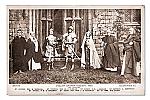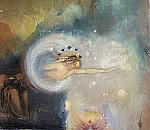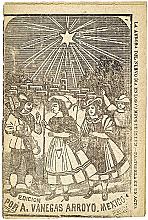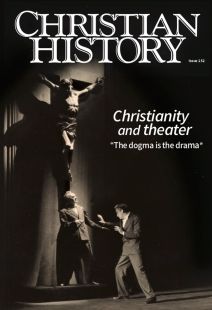From drama to life
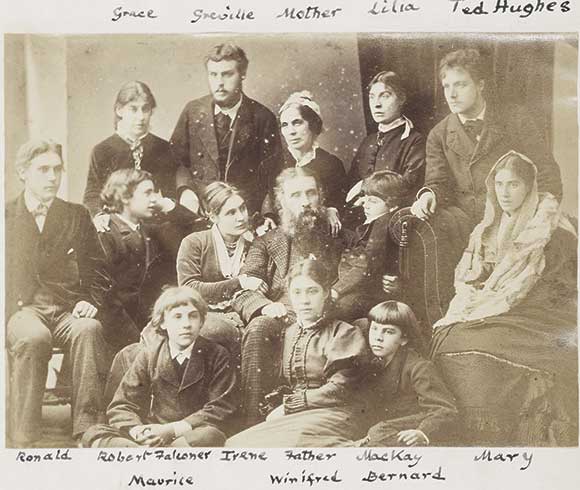
[ABOVE: The MacDonald Family in 1876 in MacDonald Family Album. GEN MSS 103, George MacDonald Collection—Beinecke Rare Book and Manuscript Library / Public domain, Yale University]
. . . as one set upon a hill, upon a stage, as in a Theatre, to play a part for God in the world.
These words from the English nonconformist John Bunyan (1628–1688) speak of the Christian life as visible to the world, communicating the gospel in daily life as a player points to the message of a play.
For still-beloved Victorian novelist and Scottish Congregationalist minister George MacDonald (1824–1905) and his wife, Louisa (1822–1902), communicating the gospel often happened upon an actual stage. Even as their family grew (the couple had 11 children in total), Louisa produced many plays, some performed by the family for their own amusement and for friends, but some as part of an education and housing project engineered by social reformer Octavia Hill (1838–1912). Hill’s aim to improve slum dwellings in London included performances of the MacDonalds’ plays.
These successful “Chamber Dramas” widened into a major production, Dramatic Illustrations of Episodes from the Second Part of The Pilgrim’s Progress by John Bunyan. Louisa focused on Christiana and her family as they followed her husband Christian, whose story the first part of The Pilgrim’s Progress tells.
MacDonald’s dramatization came at a time when many Christians frowned upon religious drama. In nineteenth-century England, theater was associated with the pursuit of pleasure, and, by connection to the popular culture of the music hall (rowdy entertainment originating in London pubs), it was regarded as a potentially corrupting influence. But for Louisa and George, drama, and this drama especially, was redemptive. A spiritual and literary influence in George’s early life, The Pilgrim’s Progress can be seen in his constant return to spiritual pilgrimage in his own works. In some ways, Christiana’s crisis-laden journey paralleled Louisa’s own, but it was the portrayal of Christiana by her oldest daughter Lilia that that brought the character to life.
A FAMILY AFFAIR
The dialogue in MacDonald’s script very closely followed Bunyan’s own text wherever possible. The play needed nineteen characters and was made of up seven scenes. With their many eager children and their friends, the MacDonalds had plenty of artistic talent; not only to act, but also to produce sets, props, and music. Louisa’s vision for spreading the gospel on stage was the driving force behind the drama. Greville MacDonald, George and Louisa’s eldest son, noted that the sense of mission implicit in Bunyan’s work—to tell the gospel to anyone who would listen—became their mission. At the same time, Louisa also realized lung disease and England’s winter climate was damaging the health not only of George but also of several of the children. Performing in different places gave her ailing family a needed change of air.
Despite controversy and initial difficulties in getting the play licensed, Dramatic Illustrations proved a success. It filled venues and began garnering professional critiques. Although it received mixed reviews, negative comments focused on the uneven talents of the actors rather than the content of the play. A biography of George summed up the overall effect: “[Y]et all who came . . . went away feeling that no performance could be more unpretentious and reverential.”
The family performed the drama over a period of 12 years, from 1877 to 1889, on a grueling touring schedule. Performances ranged over England and Scotland with some in Italy. Alongside this schedule George gave lectures, coordinating them with performances of the play.
The company managed with very few props, provided by Ronald (the MacDonalds’ second son), who described himself as
Stage carpenter and performer . . . to Mrs George MacDonald, Dramatic stage-manager, prompter, pianist, dresser, property man etc. . . . to everyone [else].
In the preface to the script, we find these props mentioned:
A wicket gate and paling . . . no scenery . . . the stage was hung with curtains of appropriate colour and design to each scene.
These curtains, as well as the costume of the key character Greatheart, are all conserved and held by the Aberdeenshire Museum Service.
“SWEET, FELLOW PILGRIMS”
The 12 years during which the MacDonald family performed demonstrate a gradual blurring of their daily lives with the imaginative drama as they toured. George himself assumed the part of Greatheart during the first tour of 1877. Since many of his friends regarded him as a spiritual guide, his role in the play became synonymous with this aspect of his life. Also, the couple’s letters to each other depicted difficult times as direct parallels to the trials met by Christiana and her family. George wrote to Louisa from Italy in the autumn of 1877:
I have once or twice been tempted to feel abandoned ------ in this messy and struggling house ------- But it is only a touch of the Valley of Humiliation ---- of the Hill of Difficulty rather.
Two years after the first performance, the family went through their own “Valley of the Shadow of Death.” Lilia wrote to one of her friends from Portofino a year after the death of Mary (the second daughter) and within a month of the death of Maurice (the fourth son). On April 1, 1879, she wrote:
You will wonder perhaps, as we did at first, how we can go through it [the drama] so soon after parting with our Maurice . . . but we thought we ought to try and are quite glad we did so, it has all come back to us with such force and truthfulness and fresh light as has made the rehearsing of it quite a help [along] the difficult path of the real daily pilgrimage. . . .
The family carried on with performing until 1889, but after Lilia, the most talented actor, died in 1891, the heart went out of all their theatrical performances. As a family the MacDonalds’ life journey continued, as did their spiritual and dramatic impact. As one friend wrote to Louisa: “Farewell, sweet fellow pilgrims and may we meet again a little further on our journey.” CH
By Rachel E. Johnson
[Christian History originally published this article in Christian History Issue #152 in 2024]
Rachel E. Johnson is a George MacDonald and children’s literature scholar and the author of A Complete Identity: The Youthful Hero in the Work of G. A. Henty and George MacDonald.Next articles
Wizards’ duels and modernist mayhem
Magic, myth, and Christ in twentieth-century theater
Sørina HigginsFrom Aztlán with love
Mexican American religious and ethnic identity played out on the stage
Daniel F. FloresSupport us
Christian History Institute (CHI) is a non-profit Pennsylvania corporation founded in 1982. Your donations support the continuation of this ministry
Donate



